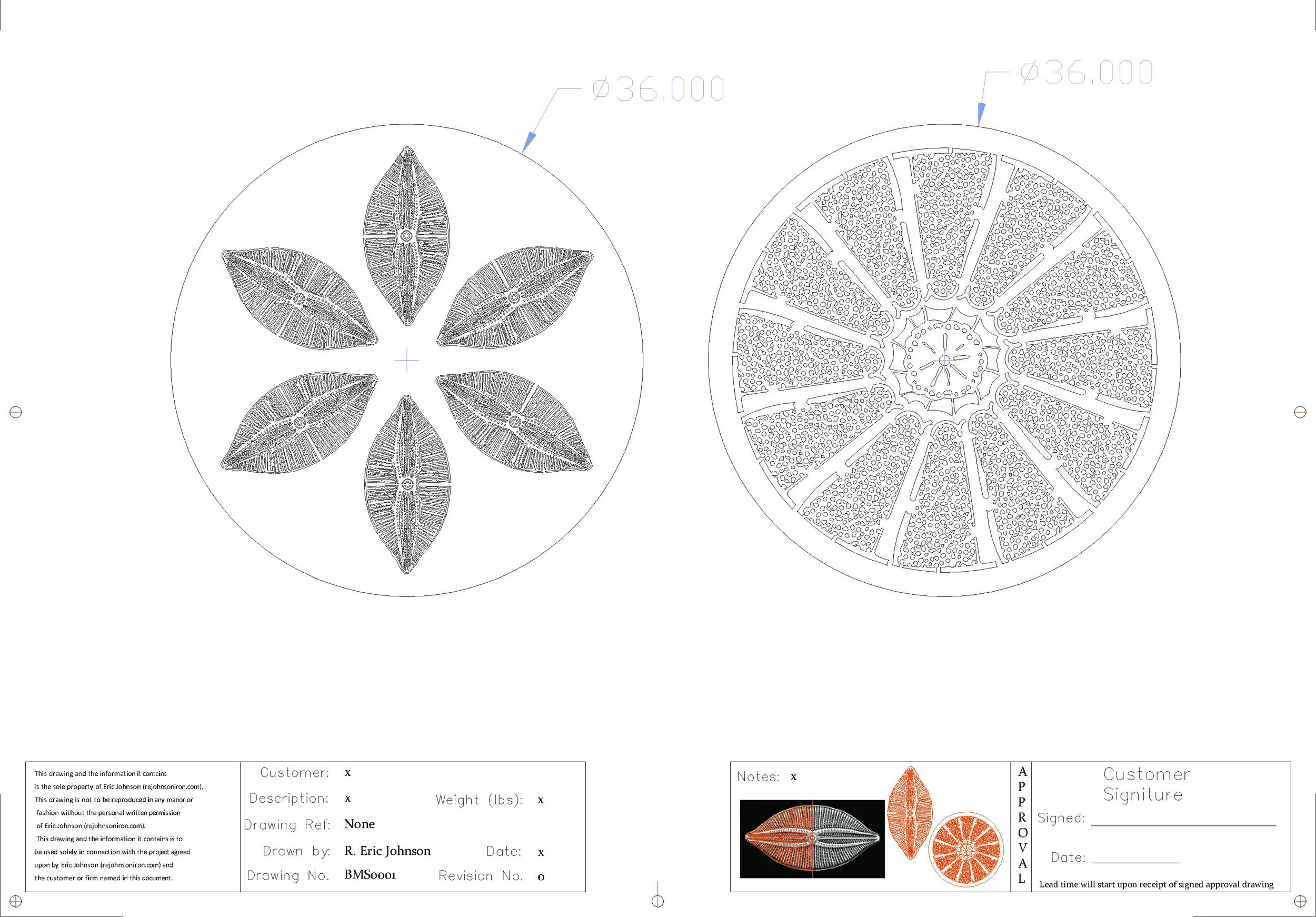Our River - Our Future
Laser Cut, Stainless & Enameled Steel with Choreographed LED Lighting
16’H x 6’W
2019
Life in Terre Haute is inextricably connected to the Wabash River. The inspiration for Our River - Our Future comes from diatoms unique to the river in Terre Haute.
The Sculpture: Our River - Our Future
The circular laser cut patterns on the Terre Haute sculpture represent microbiomes and diatoms - single cell organisms that are key indicators of the health and well-being of an environment. Diatoms that are specific to the Wabash river inspired the art patterns that are laser cut into the steel circular patterns. The overall shape of sculpture simulates the meandering of Wabash as it flows across the state of Indiana.
As with all diatoms, those in the Wabash River have a silica (or glass like) exterior casing. The circular patterns on the sculpture are vitreous enamel (porcelain enamel) imitating the silica structure of a diatom. Vitreous enamel is a material made by fusing powdered glass to a substrate through firing in an oven, usually between 1,380 and 1,560 °F. The powder melts, flows, and then hardens to a smooth, durable vitreous coating. The word comes from the Latin vitreum, meaning “glass.
During the day, sunlight shines through laser cut patterns and creates dancing shadows on the ground below, enlivening the pedestrian experience. At night the sculpture comes alive in vivid detail with choreographed LED lighting effects that simulate a river current flowing across the surface of the sculpture.
Much as these single cell organisms are the key indicators of the health and well-being of a river system, single celled microbiomes in the human body are key indicators of the health and wellness of the human body. The intricate interconnections of human microbiomes with our environment mirror the patterns of the Wabash River with its diatoms.
Jeffery Stone and his lab in ISU’s Department of Earth and Environmental Systems catalog and study the Wabash diatom community and the impact of pollutants in the watershed effects on the diatoms. The artist worked with them to select the diatoms that inspired the laser cut patterns on the sculpture. Columbian Home Products is a Terre Haute based enamel ware company that has been in business for over 148 years and worked with the artist on the enameling process for the sculpture.
Diatoms & The Wabash River
Present in every water system found on the planet, diatoms are a type of microscopic algae that use silica dissolved in the water to produce their protective skeletons. A single diatom is thinner than a human hair and yet they are the secret to the earth’s oxygen supply. Diatoms are responsible for producing all of the oxygen in one of every four breaths that you take and they absorb a tremendous amount of carbon dioxide in this process. In the right conditions, diatoms can replicate very quickly – including more than doubling their populations in a single day.
Diatoms are an important component of the food web in all aquatic systems. In rivers, diatoms make up a large part of the base of the food pyramid, converting sunlight to body mass through photosynthesis. While other algae and cyanobacteria can produce harmful, toxic, or unsightly blooms, diatoms rarely have negative or harmful effects on the environment. Diatoms usually are highly productive in river systems and provide nutrients and energy upward to larger organisms such as zooplankton, insects, and fish.
Diatom species are sensitive to the aquatic environments in which they live; species abundances can become altered based upon nutrient enrichment or deprivation, changes in pH or salinity, and exposure to sunlight. Species diversity in diatoms is mirrored by their physical diversity and lifestyle. They have a variety of shapes and sizes – some even form complex colonies shaped as ribbons, fans, zigzags, or stars.
The Wabash ecosystem has a collection of diatoms living in the river that are unique to Terre Haute, where the river runs through the city. With an understanding of how nature is structured and how it functions, we gain an appreciation and love for our environment and begin to realize the interconnectedness of everything - that healthy systems sustain healthy people and vice versa.
College of Health and Human Services - The Human Ecosystem and Microbiomes
An ecosystem is a community of living things that interact with each other. The human body is an ecosystem of microbes. Every person is a unique ecosystem of microbiomes that are key indicators of the health and well-being of the individual. Like our fingerprints, no two are the same. Each of us contains over a trillion microbes which outnumber our human cells ten to one. The microbiome is the genetic material of all microbes that live both on and inside the human body - bacteria, viruses, fungi, even protozoa.
Our unique microbiome helps digest our food, keep our brain active, and regulate our immune system by protecting against bacteria that cause disease. They are essential for human development, growth, and overall health. Many diseases such as diabetes, rheumatoid arthritis, muscular dystrophy, multiple sclerosis, and fibromyalgia are associated with dysfunction in the microbiome. Disease-causing microbes can accumulate over time, changing gene activity and our metabolic processes. New research from the NIH indicates that autoimmune diseases are not genetic through the DNA, but are rather passed on by inheriting the family’s microbiome.







